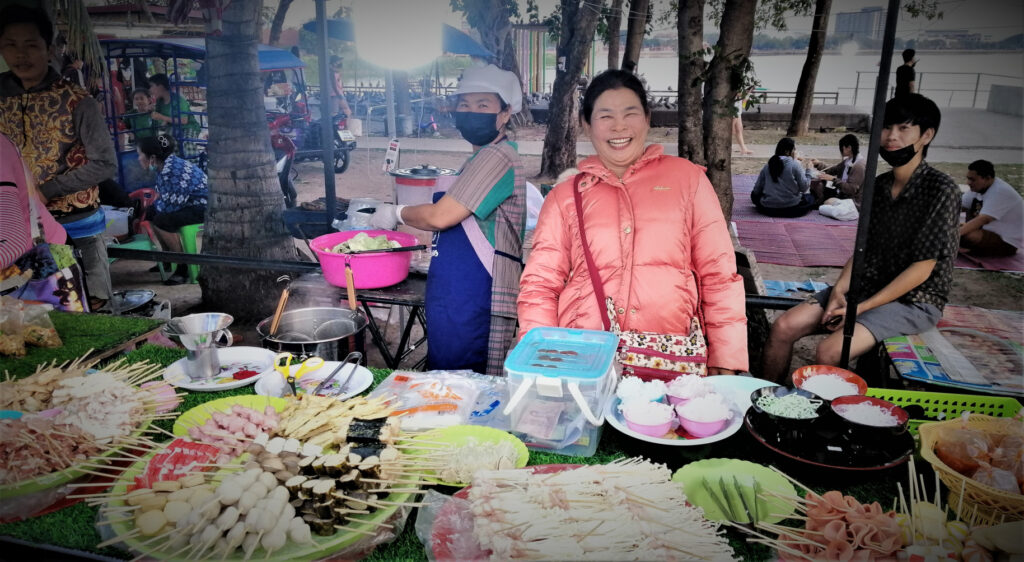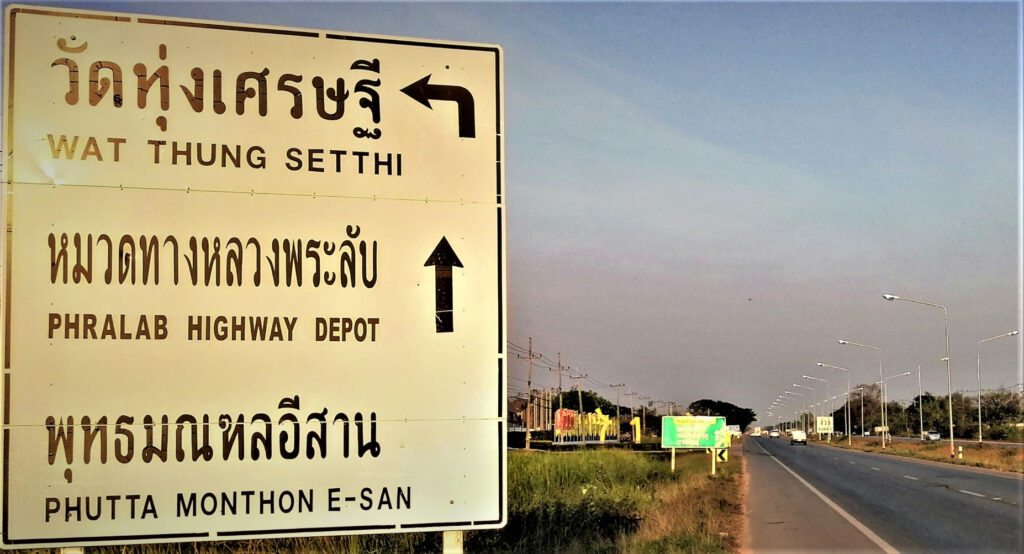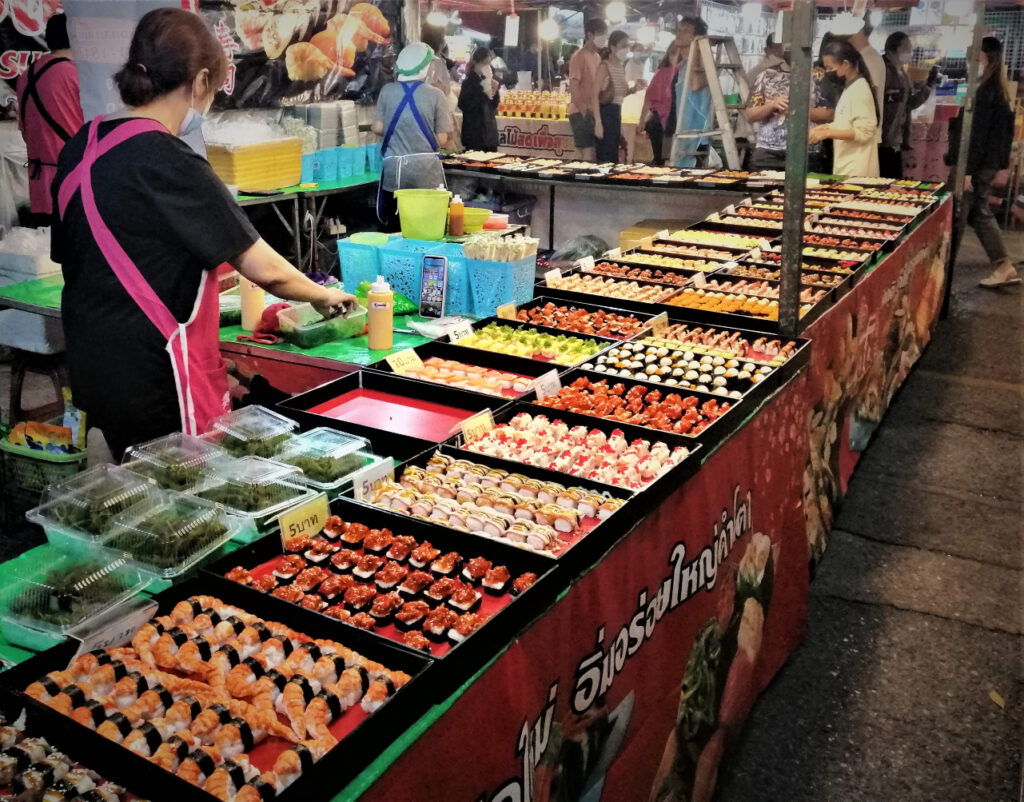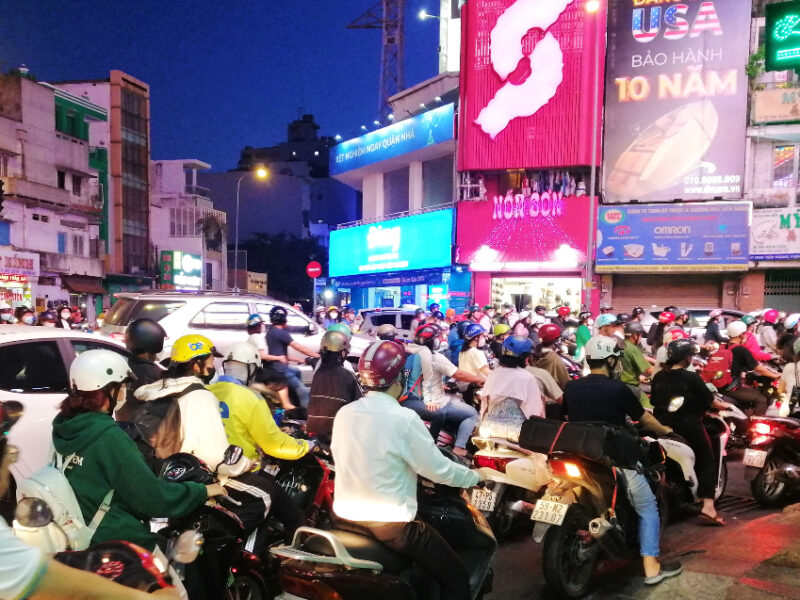I found to my pleasant surprise that Khon Kaen, Thailand is a city of unknown world wonders.
The above Thung Sethi has been compared to the Taj Majal. It’s certainly not that, as this architectural astonishment isn’t recognized on a world scale. Only the locals and a small percentage of travelers know it. Although easy to access, Khon Kaen is not a tourist town per se, but I predict that it’s on its way.
I hadn’t heard of Khon Kaen until I saw it on the screen in the train station in Bangkok a few months ago. It’s on the line that goes from Bangkok to Nong Khai, on the border of Laos. I forgot the name until it came back to me after returning to Thailand from Laos a few weeks ago.

Thailand and SE Asia are obviously loaded with historical Buddhist architecture. Founded in 1935, Khon Kaen is no different. Today it’s been designated a modern Smart City.
This pleasant municipality is a perfect place to pass time. The laid-back locale has a couple of surreal sites.
There are multiple night markets in walking distance. They’re loaded with quality Thai, Japanese and western fare.

You see few western tourists in Khon Kaen. Most bypass it or only stay a night and have no idea of the magic this jewel of a destination encompasses.
Khon Kaen isn’t well-known yet, but when the new high-speed train that runs from Kunming, China, to Vientiane, Laos, connects to Bankgok, Khon Kaen will be one of the station stops. This fast, modern transport marvel will eventually connect down to Kuala Lumpur and Singapore.

The extensive engineering endeavor is already a big boon for the Lao people and will be for more of the region.
Six weeks ago I took a one-and-a-half-hour glide ride from Nateuy, near Luang Namtha, to Luang Prabang. A year before that, I would have had to endure 10 or more uncomfortable hours on a bus or heinously squeezed-in minivan to cover the same rugged distance.
For me, Khon Kaen was about admiring a few terrific temples, frequenting quaint cafés and getting my Indochinese-gastro fill in one of the night markets each night. Unlike Luang Prabang and Chiang Rai, the low number of foreign tourists makes Khon Kaen one of my favorite cities –that I know of– in Thailand.

Genuine Thai smiles are more likely in less touristy areas.
Wat Thung Setthi: The First Architectural Wonder

If you’re in Khon Kaen, the Thung Setthi Temple is a must see. It lies on the outskirts, so you have to take a taxi or tuk tuk.
The wat is surrounded by tropical nature.
Plan to pay nung roi (100), Baht or more each way. I tried to walk twice. The first time I gave up and turned back; the second time I made it just before dusk. It took much longer than I had anticipated. There are parts of the road that are not conducive to walking so don’t attempt it.

At at this sign I was hugely relieved to be 15 minutes away by foot. This highway was not designed for walking. In hindsight, I knew I should have saved a ton of time and paid a driver.
There’s a nice café besides the exotic complex. They called me a taxi back that cost exactly 100 Baht. Two days later I took a taxi back from the site and it cost 130. The meter seemed to move faster than it had two evenings prior. The tuk tuk to get there cost 80 Baht ($2.50). You could get a motorcycle driver to do it a little bit cheaper.
Unlike many travelers who rent or purchase motored bikes in South East Asia, I prefer to keep things simple and walk, only using extra transportation when I need to. Like most things and ideas, this current travel philosophy has its pros and cons.

Finding out about Wat Thung Setthi and seeing it first hand was an incredible blessing that triggered a former epiphany:
We as humans ought to get out into the wondrous world.
Wat Nong Wang: The Second Architectural Wonder

Since it was easy to walk to, I managed to visit the remarkable Nong Wang Temple several times. I can’t say which work of architectural art is better, since they’re so different in their wondrous ways.
Like the Thung Setthi Temple on the outskirsts, Wat Nong Wang in the city is also unmissalbe if you’re in Khon Kaen.

Each level and its balcony gets smaller and more narrow as the temple floors ascend.

There are a few night markets with good cuisine-dream opportunities. While drifting around cities and in night markets I’m reminded that this is an omnipresent Indochina town.
Chinatown used to me my favorite neighborhood in Boston. Here I’m enjoying many nice culinary options available, but mostly of the non flesh food variety.

Ton Tann is the most renowned and biggest night market in the city; however, I liked the three other after-sundown markets more than Ton Tann, as they had more vegetable options and were closer to my accomodation.
Being mostly whole vegan these days, I’ve become more limited in what I try. Still, Thailand is such a food paradise that even full-on vegans manage fine. If you’re really strict and want to be fully vegan, learning some Thai food basics can help immensely, especially when you’re outside of tourist zones.
| No fish sauce | Mai nam plaa |
| A little fish sauce | Noi nam plaa |
| No pork | Mai moo |
| No chicken | Mai gai |
| No beef | Mai nua |
| No sugar | Mai nam tan |
| I am vegan | Pom/chan Jae |
l typically say:
Noi nam plaa (a little fish sauce).
This animal liquid is used copiously with papaya and cucumber salad. In the local person’s mind, fish sauce is a key ingredient to these quintessential Thai dishes that are vegan, except for the fish sauce.
Fresh, inexpensive sushi is ubiquitous to Thailand’s night markets. This is no different in Khon Kaen. Although mostly marine fare, there are vegetable and egg options, especially seaweed.
There’s crab and tuna if you care to lightly diverse from a vegetarian regimen. From my experience, wasabi in Thailand is stronger than in the US.

I have a hard time enjoying a city if I’m not able to find a good place to stay. This has not been an issue in non-touristy cities of Thailand, as these areas can provide some of the best accommodation values on the planet.

I liked this basic but spacious room at the Ruen Rom Hotel on Ruen Rom Road, just a five-minute walk from the train station. The price was right at 400 Baht ($12), per night. This included a small bathroom with hot water and even a small balcony.
The A/C wasn’t needed although it was included. I felt like I experienced a very short –one week– winter as their were five consecutive chilly mornings where a sweatshirt felt required. Like the majority of hotel rooms across Thailand, the room included two bottles of water per day and cleaning. I like space and am pleased when able to find such value.
I liked my stay in Khon Kaen as I had a great-value accommodation, mostly good walking options, excellent cafés and two previously unknown world wonders to visit and gaze upon.
While the Thung Setthi is not the Taj Majal, it also doesn’t charge $13 like the Taj Majal does. There’s a great chance you will get it all to yourself compared to the colossally-crowded site in Agra. . . at least for now.
Have you had the privilege of witnessing any wonders of the world? Leave a comment below.
Set of photos from Khon Kaen, Thailand.



Wonderful to share it with you. Thanks Michael
Such informative travelogue.
Love the pictures and storytelling of these fareaway places.
Never visited Asia so this is perfect virtual voyage. Thanks Earthdrifter!
ZY: Thanks! I’m glad you enjoyed the post!
Really impressive! Beautiful photos! Thanks!
MAMA: I’m glad you liked them! 🙂
Good stuff,Earthdrifter!
Thanks, TREVOR! Much appreciated!